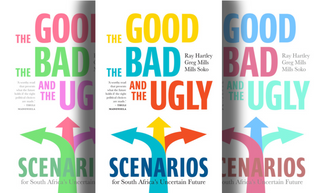News
South Africa’s Perilous Journey — our Nation’s Future is Either Good, Bad or Downright Ugly
South Africa is facing an extraordinary ‘polycrisis’. Ray Hartley, Greg Mills and Mills Soko’s book, ‘The Good, the Bad, and the Ugly: Scenarios for South Africa’s Uncertain Future’ unpacks both the devastating realities of collapse and the promise of restoration that is within grasp.

Research Director, The Brenthurst Foundation

Director, The Brenthurst Foundation

Professor of International Business and Strategy at the Wits Business School


South Africans are living in a crisis that is multifaceted, characterised by a weak education system, an energy crisis, failing transport networks and endemic corruption.
In their new book, ‘The Good, the Bad, and the Ugly: Scenarios for South Africa’s Uncertain Future’, Ray Hartley, Greg Mills and Mills Soko demonstrate the various routes that the country could go down, and explore possible solutions to grasp hold of a better future.
“The scenarios presented in this book are a gift to South Africa of a foresight lens on what the future holds if different political choices are made and the interplay with anticipated domestic and global ecosystem factors is considered,” writes Thuli Madonsela in her foreword.
“Ultimately, the scenarios give us a glimpse into possible futures from which we must choose. The call is for all to exercise political will to bend the future towards the South Africa we want.”
Read an extract below.
***
If you don’t know where you’re going, any road will take you there.
— George Harrison
In December 2022, The Brenthurst Foundation and the In Transformation Initiative released a set of scenarios for South Africa, with the title ‘The Good, the Bad, and the Ugly’. It soon became clear that South Africans were keen to discuss, debate and comment on the scenarios, possibly because the future had never been less certain.
The idea of the scenarios was born after Roelf Meyer, leader of the In Transformation Initiative, and Dr Greg Mills, director of The Brenthurst Foundation, and others concerned about the future met to discuss how best to confront the country’s growing crisis.
The scenarios were released as the country teetered on the brink of yet another disaster when ‘load shedding’, a euphemism for insufficient electricity production by the state energy monopoly, Eskom, entered its fourth consecutive month. At the time of going to print, load shedding had taken place on a daily basis — with the exception of one or two days — for 12 months. Outrage was growing as jobs and livelihoods, already buckling under massive unemployment and poor growth, faced this serious new threat.
The motivation was simple: to get past the heated emotions about the state of the country that were dominating the national conversation, particularly on social media, and try to have a rational discussion about South Africa’s future and the key decisions that would shape its destiny. These decisions can move South Africa on the road to growth and shared prosperity or they can shift the dial the other way, opening the door to economic collapse, rising poverty and, ultimately, failure.
Mills consulted with South Africa’s foremost scenario planner, Clem Sunter, who had produced scenarios in the 1980s that had a massive impact on the country’s trajectory.
Sunter had persuaded the Anglo-American Corporation, where he subsequently became head of the gold and uranium division — the world’s largest producer at the time — to establish a scenario-planning function. He produced a presentation called ‘The World and South Africa in the 1990s’, which was widely followed in the country.
Sunter boiled South Africa’s biggest choice down to a decision to follow ‘The High Road’ to a negotiated end to apartheid or ‘The Low Road’ of civil war, destruction and a wasteland. He would go on to write a series of best-selling books, perhaps the best known of which was The Mind of the Fox: Scenario Planning in Action, co-authored with Chantell Ilbury.
Writing about his approach, Sunter says: ‘To be a fox, you have to consider all the frames of reference that can affect your business, from the state of the international economy to the state of your country or city, to the state of your industry, to the state of your company or organisation, to maybe the state of your business units and the departments that make up your company or organisation. You should also hold all the scenarios simultaneously in mind as potential “truths”. As in the world of quantum physics, there is nothing contradictory in doing this. It is only after the period to which they pertain is over that they collapse into one “truth” – and even then, history is often the subject of heated debate.’
It was important to remember that the future was never certain, says Sunter. ‘The future only happens once, so it is not like a laboratory experiment you can repeat to obtain a statistical pattern of outcomes. Furthermore, much about the future where mankind is concerned is determined by “animal spirits” — a Keynesian expression — where pure emotion is responsible and difficult to predict.’
Scenarios can, however, affect the future by outlining the consequences of big decisions for the country.
Among those persuaded to act by the scenarios presented by Sunter in the 1980s was Meyer, who then spearheaded the National Party’s decision to seek a negotiated settlement. Sunter presented his scenarios to President F.W. de Klerk’s cabinet, and Meyer, who, with the support of De Klerk, became a key negotiator alongside Cyril Ramaphosa, then the African National Congress (ANC) secretary general. Sunter also visited the imprisoned Nelson Mandela shortly before his release to discuss the future.
History has a way of producing these strange cascades. Three decades after the negotiated settlement, Meyer once again believed the country — now led by Ramaphosa — faced some stark choices.
After receiving advice from Sunter, Mills and Meyer drew up The Brenthurst Foundation scenarios, roughly following the ‘rules’ of scenario planning. The scenarios start out establishing ‘Five Rules of the Game’ — the immutable fundamentals that shape the decision-making environment. Then the scenarios look at ‘The Big Unanswered Questions’, mapping out the main choices that must be made. After that, there is an examination of ‘The Fraught Global Context’, in which South Africans must make their choices.
Finally, there are the scenarios themselves: ‘The Good’, where the right reforms are undertaken and lead to better governance and economic growth; ‘The Bad’, where populist economic choices send the country into a spiral of decline and disaster; and ‘The Ugly’, where the country continues to muddle along with conflicting policies, a journey down the road to nowhere and, ultimately, to the same disastrous economic destiny, albeit at a slower pace. A fourth scenario, expanding on the Clint Eastwood theme, was decided on. ‘A Fistful of Cents’ sees a small, rapacious elite enriching itself through rents and corruption as poverty and inequality grow, with the state failing to act. It goes without saying that these scenarios might overlap or even be blended, but these are the four most likely directions the country could take.
Each of these scenarios is possible and which one will come about is dependent not on arbitrary events, but rather on the decisions and actions of the country’s leaders. The scenarios sought to spell out how these decisions would impact on the future by mapping their consequences, based on the experiences of other countries.
A week after the scenarios were released in December 2022, the ANC held its elective conference where just such a set of decisions was made. The ANC conference would have enabled the ‘Bad’ scenario if its Radical Economic Transformation (RET) faction, led by those fingered for state capture, such as former President Jacob Zuma and disgraced former ANC Secretary General, Ace Magashule, had won the day. Our view was that, in such a scenario, the ANC’s electoral support would plummet, and it would form a natural alliance with Julius Malema’s Economic Freedom Fighters (EFF), leading to rapid decline under failed populist policies. As it turned out, the RET faction was decisively defeated, leading to this scenario being less likely in the short term. This does not mean that the faction that won the day will automatically make the right choices, but they are more likely to do so than the RET faction. The rise of Paul Mashatile to the position of ANC deputy president gave the Bad scenario new life, as he appeared willing to accommodate the EFF in a coalition.
But scenarios have to adapt to changing events. Even as the RET threat was put back in its box, the continuation of load shedding into the new year began to emerge as a major limitation on future growth. Without the energy to power a growing economy, and with the government apparently bereft of ideas about how to change this, it now seemed that the ‘Ugly’ scenario — a slower but just as devastating downward spiral — was back on the cards.

Not all metrics are what they might seem at first glance. Is the rise of the number of South Africans receiving social grants an achievement or a symptom of economic decline and the absence of jobs? There are further layers of complexity. There are social grants that are for the elderly, who would not work even if the economy was growing. There are also disability grants as well as child grants. These are normative choices that could be made however the economy is performing. There is then the Social Relief of Distress Grant, imposed during Covid-lockdown and then extended, which is an anomaly beyond its initially intended purpose.
Is our improving matric pass rate proof that we are advancing or the result of a drop in the standard required to pass? Is private sector and household investment in renewable energy a positive shift to green energy or evidence that the state monopoly is failing to deliver, forcing unnecessary expenses onto private balance sheets? Again, there is complexity. Even under the best of circumstances, households and businesses should be moving in the direction of clean energy but with better structured incentives from government. So, something positive is emerging from a dire situation, but are government incentives sufficient? Are there enough resources to ensure resilience in households, especially against the backdrop of the cost-of-living crisis?
These scenarios come at a difficult moment in South Africa’s political and economic history. By the middle of 2023, the load shedding crisis had escalated dramatically and was the most notable symptom of the collapse of governance. There were many others, including outbreaks of cholera, the number of public delivery protests, the state of the country’s public hospitals, the breakdown of the country’s rail network, the rate of chronic and rising unemployment and, chillingly, the levels of criminal violence. Police Minister Bheki Cele admitted in February 2023 that 7,555 people were murdered between October and December 2022, and 3,144 of these were by firearms.3 During that year, an average of 30 people each day were shot and killed, or 10,950, more than were killed by the Rhodesian security forces in 15 years of armed conflict. To provide further context, over more than 20 years, South Africa’s Border War is estimated to have cost 22,000 deaths, including 2,365 among apartheid security forces (including so-called South West African forces) and around 1,000 civilians and more than 2,000 Cuban troops.
There is an economic dimension to this chaos. The largest platinum and gold producer in South Africa, Sibanye Stillwater, in 2022 spent approximately 2% of its R100-billion turnover on security, while losing the same amount each to load shedding and theft. The levels of risk also considerably discount South African assets and make more difficult the sale of the country on the international stage to investors, a challenge compounded inter alia by South Africa’s support for Russia in the war with Ukraine. Sibanye Stillwater reckons on a 35% discount on its share price for its African operations. This premium also makes large-scale capital investment unlikely, at least in the mining sector, where recovery and profit are calculated over a generational time-scale, explaining the fall in employment of this sector by over 50% to just 458,954 workers in the last 30 years.
The country’s governance record and the patronage driven nature of its political economy explains why. For example, of 257 municipalities countrywide in South Africa, just 41 received a clean audit in 2021, of which the majority were run by the opposition Democratic Alliance (DA). The Auditor-General reported that 73% of municipalities in the DA-run Western Cape received clean audits (22 out of 30), while municipalities in the other eight provinces, mostly run by the ruling ANC, averaged just 8% (or 19 councils out of the 227 ruled by the party).
In 1960, the average South African’s share of global per capita GDP was 107%. While it is important to note that racial inequity was deeply entrenched under the apartheid policy, the average income nonetheless tells us that it was punching above its weight on the world stage when it came to economic performance. Sixty years later, in 2020, the average South African’s share of global GDP had plummeted to just 54% of the global average. While the world moved ahead, South Africa fell back sharply. The effects can be seen in rising unemployment and criminality. The expanded definition of unemployment, which includes those discouraged from seeking work, was 42.6% in 2022. The government’s own statistics show that long-term unemployment has almost doubled in the 10 years since 2012.6 The problem remains low rates of economic growth. While there is clearly more to life than economic growth, irrespective of where the poverty line is set, economic growth is necessary to ensure no one lives below it.
In this respect, while South Africa might have avoided all-out civil war through the remarkable political transition in 1994, it has since lost the peace.
A SWOT analysis
These, and other issues, are best summarised by Figure 1.2, which identifies South Africa’s strengths, weaknesses, opportunities and threats (SWOT).
It is important to note amidst the doom and gloom that there are several strengths that persist, albeit under increasingly challenging circumstances. Just as importantly, there can be no glossing over the serious weaknesses the country faces. The key question is whether South Africa understands where its opportunities lie and how to deal with its threats going forward.
Yet, for all of these problems, the country’s future is not preordained, and nor should South Africans regard themselves as mere spectators in this process. These scenarios should empower South Africans – and others – to find the tools to engage with these complex issues and then map out the choices that have to be made.
The stakes are high. How these difficult choices are made will determine South Africa’s trajectory for decades to come.
This article originally appeared on the Daily Maverick
Photo: Supplied

